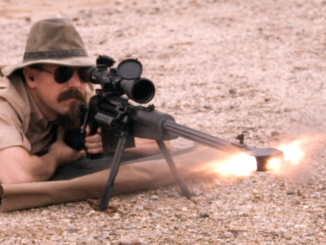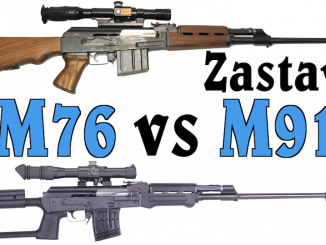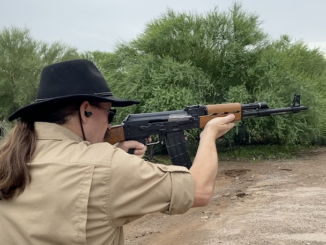Rifle in this video is selling at auction here.
Serbia in the 1890s was not a large or wealthy kingdom, and they had no domestic arms manufacturing capacity – but they did appreciate a good rifle and a good cartridge. The Serbian Army was armed with their M1880 rifle, which was a slightly improved Mauser 1871 single shot design, chambered a the Serbian-designed 10.15mm cartridge. By the mid 1890s this was seriously obsolete, and Serbia began to look for ways to replace it.
In 1898 they were able to secure a loan from the Austro-Hungarian Empire to purchase new rifles, and they chose the 1895 pattern Mauser, in 7x57mm. However, Mauser was at that time at full capacity making rifles for Turkey, and had to hand the Serbian order off to DWM. By the end of 1900 the full order of 90,000 rifles (plus a stockpile of ammunition) had been delivered, and most of the Serbian fist Ban forces were back on technological par with the rest of the world. These Model 1899 rifles would be followed by the 1899/07 and the Model 1910, both of which were basically the same action in the same caliber.
In World War One, the Serbs with their Mausers would make a good first showing against (ironically) the Austro-Hungarians forces, but they did not have the stamina or resources to repel a second major offensive in 1915, when the Serbian Army was routed and forced to evacuate to the Greek island of Corfu. Most of their arms were lost in the process, and the Serbian Mausers would see no more organized use in the Great War (the army was re-equipped with French rifles instead).




” in 7x57mm”
Are whyabouts of this decision known? Was any country adjacent to Serbia used it at that (1898) time?
“against (ironically) the Austro-Hungarians forces”
In short time perspective yes, but at longer not necessarily – in 19th century Prussia and Austria-Hungary were competitors to dominance in that part of Europe (cf. Königgrätz 1866)
There is a difference between 1899 and 1899/07 – 07 has “safety breach” and uses fully supported chamber.
1910 was improved gew98 action, but also featuring fully supported chamber.
That will be distinguishing mark of later M24 and M48 rifles also.
AFAIK only Costaricam 1910 Mauser also featured fully supported chamber.
Caliber was chosen for a fact that rifles in it would be ready for delivery faster than any other (7.65 and 6.5 were considered)
This might be obvious question, but did Serbian forces used these rifles in earlier war – namely Balkan War, that is that war where Tsardom of Bulgaria fights against Serbia, Greece, Montenergo, Romania and Ottoman Empire?
Yes, M.99, M.99/07, M.10 rifles and M.08 cavalry carbines were used in both Balkan wars – 1st one with Bulgaria, Montenegro and Greece vs Turkey and Second with Greece, Montenegro, Romania and ironically Turkey vs Bulgaria.
Yes they did use them in 1st and 2nd Balkan wars, where a lot of guns were lost. This was the reason why Serbia entered WW1 with a mix of Mauser 99s, seized Turkish Mausers (seized in 1912), surplus South American Mausers bought from international arms dealers (esp Mexican Mausers in 7mm, but I think some Peruvian too?…), and a LOT of obsolete guns like the Mauser Milovanovic, Mauser Djuric, Russian Berdan…
Technical question:
Youtube auto-generate Korean subtitles for me for that clip. Something is wrong with Youtube or my browser? Anybody has similar issue?
Some informations regarding disastrous Serbian retreat, called as “Serbian Golgotha” too:
https://en.wikipedia.org/wiki/Serbian_army%27s_retreat_through_Albania
WTF?? The Closed Captions appear to be in KOREAN. What happened?? 🙁
Didn’t Lowe, which became the gunmaking part of DWM, own Mauser as of 1887? This was like a handoff from Chevrolet to GMC.
Staghound,
you are correct. Mauser was no longer independent.
In 1896 Loewe founded DWM as a shareholder of all its arms and ammunition making actvities. DWM made the business decisions.
Rock Island lists it in 8mm
Is that a typo on their part????
typo mistake. It s 7×57 ammo
The Serbian Mauser rifle was a minor variant of the Spanish 7 mm model 1893 rifle.
Spain began trials to replace the Remington model 1871 in 1890. The Army Board initially elected the Belgian Mauser in 7.65 mm and tested a model similar to the Turkish model 1890. In 1892 Paul Mauser offered an improved version, but the question of caliber was no yet settled, it was considered the fashionable 6.5 mm (like Italy or in brief Romania). But the Spanish Board previewing the future shortcomings of 6.5 opted for a compromise caliber, the 7mm. Finally Mauser presented the Mauser model 1892, with improved extractor, and the new in 7 mm Mauser (according to Spanish requirements). It was adopted in dec. 1892, placing an order for 70.000 rifles, and was also approved the acquisition of machine-tools for the Oviedo Arms Factory.
Next year, in 1893, and before no more than 5000 model 1892 carbines had been delivered, Mauser offered an improved version with staggered row magazine, the definitive model 1893 Spanish Mauser. New orders were placed for the necessities of war, as the Cuban insurrection had begun in 1895. Orders in Germany were fulfilled mainly by Ludwig Loewe, and its successor DWM. In a couple of years production in Oviedo was added.
This rifle established the new Mauser standard until 1898, and Spanish model (so was called by Mauser) was purchased, with minor modifications, by several Latin-American countries, Brazil (Model 1894), Mexico & Chili (Model 1895), later from 1896 by the Boer Republic (ZAR), and finally by Serbia (model 1899).
The Spanish 7 mm model 1893 rifle was the first that demonstrate the excellence of Mauser rifles in combat, in the Cuban insurrection (1895-98) and later against the U.S. Forces that landed in Cuba in 1898 (Spanish-American War). Its superior performance in the hands of Spanish soldiers against the Krag-Jorgensen of U.S. Army determined the adoption by the U.S.A. of a new Mauser patent rifle, the Springfield model 1903.